On October 14, 2025, SpaceX launched Starship Flight Test 11 from its Starbase site in South Texas. This mission marked a major milestone: it was the final flight of the Block 2 (“V2”) version of Starship, designed as a culminating demonstration before transitioning into next-generation iterations.
The vehicle stack used for Flight 11 comprised Booster 15 (B15-2) and Ship 38 (S38). For the booster, this was a return to flight: B15 had flown in Flight 8, and was refurbished and prepared for this mission. The upper stage, Ship 38, had undergone cryogenic testing and static fire campaigns ahead of launch.
Flight 11 followed a broadly similar trajectory to Flight 10, but with new experimental elements baked in, especially in booster landing strategy, heat-shield testing, and flight profile maneuvers.
Mission Profile & Timeline
Here’s a condensed timeline of critical mission events during Flight 11 (source):
| Time (approx) | Event | Notes / Outcomes |
|---|---|---|
| T-00:10 to liftoff | Raptor ignition, liftoff | Launch initiated as scheduled |
| +00:01:02 | Max Q | The vehicle passed peak aerodynamic stress successfully |
| +00:02:37 | MECO (Booster engine cutoff) on Super Heavy | Primary engines shut off, preparing for stage separation |
| +00:02:39 | Stage separation & hot staging | Starship’s own Raptor engines ignited while booster detached |
| +00:02:49 | Boostback burn (Super Heavy) | Nine out of ten engines relit (partial deviation from target) |
| +00:03:38 | Boostback shutdown | Booster completed its show of powered maneuvering |
| +00:06:20 | Landing burn start | Super Heavy began its descent/lowering thrust phase |
| +00:06:36 | Booster landing burn shutdown | The booster’s final descent phase succeeded |
| +00:08:58 | Starship engine cutoff (SECO) | Upper stage ended its burn and then coasts onward |
| +00:18:33 to +00:25:33 | Payload deployment demo | Eight dummy Starlink satellites were released between these times |
| +00:37:49 | Raptor in-space relight | Ship 38 relit an engine successfully in orbit — critical for future Lunar/Mars missions |
| +01:03–01:06 | Atmospheric reentry, landing burn, splashdown | Ship performed a dynamic banking maneuver, then deployed landing burn and splashed down in the Indian Ocean ~66 minutes after launch |
The booster splashdown occurred in the Gulf of Mexico, approximately four minutes after separation, while Ship 38’s splashdown was precisely targeted inland off the coast of Western Australia in the Indian Ocean.
The mission also included several experimental steps:
- New booster landing burn strategy: At launch, the booster ignited 13 engines, then switched to a 5-engine divert configuration during its final maneuvers — a configuration that will be a baseline for future Block 3 boosters’ redundancy and reliability.
- Selective heat-shield tile removal: SpaceX intentionally removed some tiles in “vulnerable” areas to stress-test reentry performance under less-than-ideal thermal protection scenarios.
- Dynamic banking maneuver prior to landing: To simulate the path future missions returning to Starbase will take, the upper stage executed a subsonic banking turn before commencing its landing burn.
These were not merely decorative – they were designed to gather data for the next generation of Starship vehicles.
Why Flight 11 Matters
A Fitting Finale for Block 2
Flight 11 was deliberately the last hurrah for the current Starship (Block 2) design. With this success, SpaceX confirmed that the architecture was fundamentally sound, having achieved back-to-back successful full-profile flights (Flight 10 and Flight 11) following a string of earlier failures. The company is now free to shift attention and resources toward Block 3 / Version 3 and even later “Future Starship” iterations.
Validation of Advanced Maneuvers & Redundancy
The successful execution of new engine configurations, banking maneuvers, and tile stress tests demonstrates that SpaceX is iterating rapidly and pushing boundaries of robustness. The fact that Booster 15 flew again (its second reflight) after refurbishment underscores the viability of reusability, a cornerstone of Musk’s vision for frequent, economical space access.
Preparing for Lunar & Martian Missions
One of Starship’s critical capabilities is its ability to relight engines in orbit — essential for maneuvers on the Moon and Mars (e.g. trans-Earth injection). Flight 11 validated that feature once more. Additionally, the refined booster landing profile and stress testing of thermal protection highlight SpaceX’s forward engineering focus.
Infrastructure Transition at Starbase
This launch was from Pad-1, which is now slated for refurbishment to support the next iteration of Starship. New orbital launch mount components, upgraded flame trench systems, and enhanced “chopstick” arms for catching returning vehicles are expected. During this transition, upcoming launches will shift to Pad-2.
Challenges, Risks, and What’s Next
While Flight 11 was a triumph, it’s not devoid of cautionary notes and open questions:
- The boostback burn showed a slight deviation: only 9 of 10 engines relit, rather than full authority. SpaceX will need to analyze whether that was hardware, propellant, or control-limitation related.
- The selective removal of heat-shield tiles is useful for learning, but over time, pushing too far may reveal unexpected vulnerabilities in reentry stress or durability as flights accumulate.
- Transitioning to Block 3 / Version 3 brings scaling challenges — more engines (e.g. V4 is rumored to have 42 Raptors), increased structural stresses, and new aerodynamic regimes.
Looking ahead, the next test flights (Flight 12 and beyond) will likely explore:
- New Block 3 or “Future Starship” prototypes with increased thrust and new configurations
- More aggressive reusability cycles (faster turnaround, more flights per booster/ship)
- Payloads with real missions (beyond dummy Starlink simulators)
- Crewed or near-crewed demonstration missions, possibly tied to NASA’s Artemis lunar architecture
Conclusion
Starship Flight 11 stands as a dramatic and fitting finale for the Block 2 era — validating maturation of the design, showcasing advanced control and landing strategies, and clearing the runway (literally and metaphorically) for the next generation of Starship. With this success in hand, SpaceX enters a new chapter, pushing toward a future where routine access to the Moon, Mars, and beyond becomes not just dream, but operational reality.



